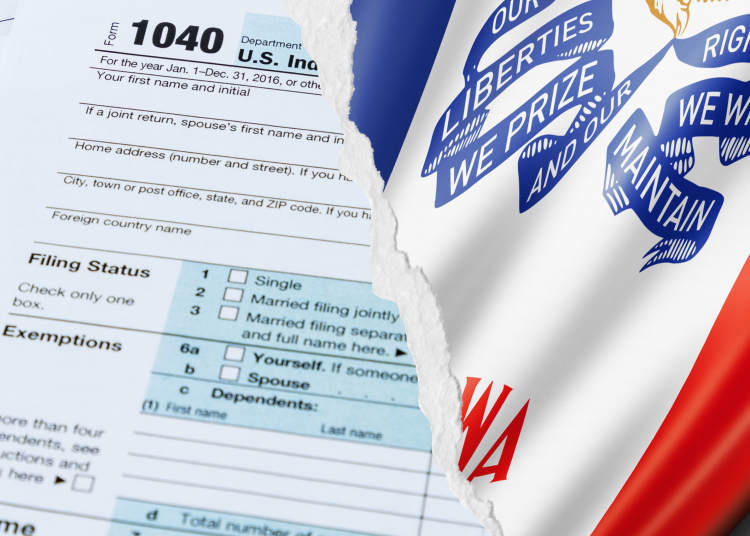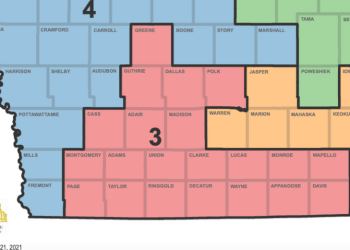Governor Kim Reynolds is growing Iowa’s economy by making the tax code more competitive and ensuring that hardworking taxpayers get to keep more of their money. During her Condition of the State address, the Governor stated that not only do we “need to continue the conversation about cutting taxes,” but she also called for the repeal “of the unnecessary triggers that were put in place in 2018.”
As legislators worked to draw this legislative session to a close, yesterday they passed a comprehensive tax relief package on a bipartisan basis that is estimated to provide $1 billion in tax savings for Iowans. This tax relief package is a victory for the taxpayer, but tax reform is far from complete.
Tax reform is never an easy process as spending must be considered. Tax reform can be revenue neutral, but the most pro-growth tax rate reduction requires limiting spending. This legislative session was especially difficult for tax reform.
Governor Reynolds and Senate Republicans made tax reform a priority, while House Republicans tended to be more cautious. A reason for this cautious approach by House Republicans was the fear that the COVID-19 pandemic could still threaten the economy and Iowa revenues. However, this fear was misplaced as the economy is in recovery.
Even heading into the pandemic, Iowa’s fiscal house was in strong order. As the legislative session began, Iowa had a budget surplus, and the reserves were full. Iowa was prepared for the pandemic emergency thanks to the prudent budgeting by Governor Reynolds and the Republican-led legislature. Both the Governor and the legislature deserve credit for following a policy of fiscal conservatism.
Senate Republicans, at the outset of the session, pushed for tax relief that would eliminate the 2018 revenue triggers and end the obsolete inheritance tax. Senate Republicans, in an effort to lower property taxes, also proposed eliminating the county mental health property tax levy and phasing out the backfill. The backfill resulted from a previous property tax reform law that provided aid to city and county governments to make up for lost commercial property tax revenue.
The comprehensive tax relief measure achieved the tax relief goals advocated by both the Governor and Senate Republicans. Some of the major provisions include:
- Eliminates the 2018 revenue triggers: The 2018 tax reform law designed two stringent revenue triggers for income tax rates to be reduced in 2023. The first, state revenues were to surpass $8.3 billion, and the second required revenue growth of at least four percent during that fiscal year. Eliminating both triggers removes an unnecessary impediment to rate reduction.
- Eliminates the death tax: Iowa is one of six states that still have an inheritance tax. It will now be phased-out over a five-year period.
- County mental health levy: This property tax levy will be phased-out over two years and the general fund will assume funding of mental health.
- Phase-out of the backfill: The property tax backfill will be phased-out over a four- and seven-year period depending on the city and county, which will provide them time to prepare for the elimination of the backfill.
- Paycheck Protection Program (PPP): Grants received from the federal COVID-19 program will be exempt from state taxation.
- Bonus depreciation: Iowa’s tax code will now be coupled with the federal tax code regarding the purchases of equipment and other capital assets.
The measure also includes numerous other provisions, including several tax credits. The expansion of tax credits in Iowa is a growing concern because it creates complexity in the tax code and makes future tax reform more difficult. Policymakers need to apply greater oversight over tax credits and eliminate those that are ineffective.
Although revenues in Iowa are growing and it appears that both revenue triggers would be met, eliminating the revenue triggers will provide greater certainty for taxpayers. In 2023, the top rate will fall to 6.5 percent and the individual income tax brackets will be condensed from nine to four brackets with a bottom rate of 4.4 percent. In addition to the rate reduction in 2023, federal deductibility will be eliminated.
Although this tax relief law is a victory for the taxpayer, Iowa cannot afford to become complacent. Iowa’s individual and corporate income tax rates are still high and further property tax reform is needed. Recently the American Legislative Exchange Council (ALEC) released the 14th annual Rich States, Poor States: The ALEC-Laffer State Economic Competitiveness Index, and Iowa’s ranking for economic outlook fell from 27 in 2020 to 33 in 2021. One reason for Iowa’s decline in the rankings is that other states are working to reduce their tax rates. Iowa cannot afford to become complacent as it is competing with 49 others states for both jobs and people. The recent census data demonstrates that states that have no income tax or states that have income tax rates that are low are gaining population.
Future tax reform must be contingent on following a path of fiscal conservatism by keeping spending levels low. Iowa has demonstrated that tax rates can be reduced while also providing for the priorities of government. Other states, such as North Carolina, Indiana, and Utah, have also proved that limited government policies work.
In preparing for future tax reform, policymakers should keep these ideas in mind:
- Tax reform takes time: Prudence is vital for any tax reform. A legislator from North Carolina correctly described tax reform as an “evolution, not a revolution.” An Indiana legislator advised other state policymakers to “act boldly and implement slowly.” Both North Carolina and Indiana have enacted different yet successful tax reform and relief measures which can serve as models for other states.
- Spending Matters: Government spending is at the heart of tax policy. Most states require a balanced budget, so policymakers need to be aware of larger economic trends. It is a reality that cannot be ignored. Over 75 percent of Iowa’s budget is consumed by education and Medicaid spending. These expenditures provide little room for other spending priorities and make reducing tax rates more difficult. Tax reform will require spending to be prioritized, and hopefully, in the process, budget reforms are developed. This also includes evaluating and eliminating wasteful tax credits and other exemptions.
- Revenue triggers can be a useful tool: Many states have proven that revenue triggers can be an effective tool to lower tax rates and help protect their budget. However, they should not be too restrictive that it results in hindering tax rate reduction.
- Truth-in-Taxation: Lowering individual and corporate income tax rates is important, but Iowa must also address property tax reform. A Utah-style Truth-in-Taxation law would provide greater accountability and transparency for property taxpayers. At the heart of Truth-in-Taxation is direct notification, which requires local governments to inform taxpayers how much their property tax bill would increase and make it more difficult for local officials to collect windfalls from increased assessments.
Governor Reynolds and the Republican-led legislature continue to fight for taxpayers in Iowa. If policymakers continue to follow a path of fiscal conservatism, Iowa could become a pro-growth leader in the Midwest.
















